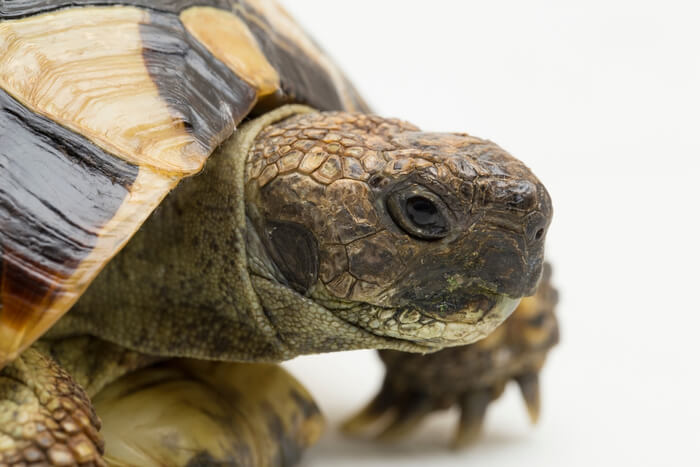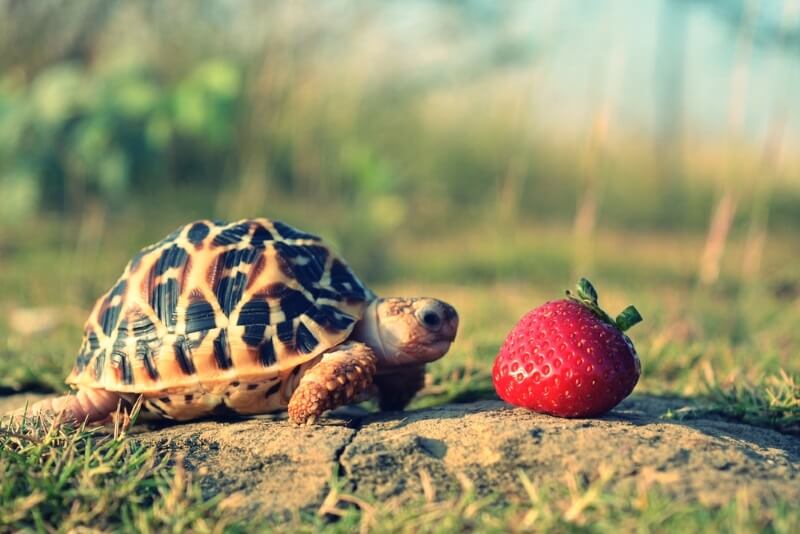Caring For A Hermann’s Tortoise: All You Need To Know
This page contains affiliate links. We may earn money or products from the companies mentioned in this post through our independently chosen links, which earn us a commission. Learn More
Hermann’s tortoises can make really great pets for the right person. They have a unique yellow and black shell that’s very decorative. This article will help you understand their special needs and decide if they’re the right pet for you.
Care

Care of a reptile requires the proper temperature, lighting, humidity, substrate and size. Hermann’s tortoises live 30 or more years in captivity, and some reports suggest that they can live 50-100 years with good care.
They are a species of conservation concern, so make sure you look for a captive-bred animal to adopt. Wild-caught animals reduce the wild population in their native territory in Europe and could lead to further threats to the species in the wild. If you want to learn more about them in the wild take a look at this article.
Cage Size
Hermann’s tortoises have a few different subspecies that grow to different sizes. Depending on which one you get, they can grow to be between 5 and 11 inches in length and up to 9 pounds as adults. Keep that in mind when you make plans for enclosures. A 20-gallon aquarium is fine for a juvenile, but your tortoise will quickly outgrow something that small. Indoors, an adult will need at least 2 feet by 4 feet of space with a 12 inch wall to prevent escape.
In the right climate, they can be kept in an outdoor enclosure. The area should be 3 x 3 feet or larger. Outdoor enclosures will need a strong perimeter fence or wall that extends 2 feet above the ground and at least 3-4 inches below the surface so they don’t burrow under the wall and get loose. Outdoor enclosures also need to protect them from animals like raccoons and dogs that may cause harm.
If multiple tortoises are housed together, the enclosure should be increased by the same area for each tortoise added.
Substrate

Both indoor and outdoor enclosures require a substrate that allows some shallow burrowing, since that’s an important natural behavior for these animals. Most soils in outdoor yards will be fine. Ensure the area has good drainage and no treatment with pesticides or fertilizers. If there’s not good drainage, then the existing ground cover should be replaced with soil over gravel. Edible plants are also an option in the outdoor enclosure.
Indoors, 4 or more inches of sterile potting soil mixed with coconut fiber is best. Cypress or aspen wood chips can also be added for a texture variety. Avoid pine and cedar since they have irritating oils that may contribute to respiratory irritation. Learn more about the coconut fiber substrate in our article on the best turtle substrates.
Temperature
Either indoor or outdoor enclosures need a temperature range between the lower 70s and 85°F. They also require a basking area of 90-95F. Indoors, a heat lamp or ceramic heater will provide the basking heat. Make sure that the lamp is mounted in a way that won’t allow direct contact. Provide multiple basking areas for enclosures with multiple animals. At night the temperature can drop to the upper 50s F.
Outdoors, the sun acts as the heat source in the right climate. Provide a shelter that allows protection from the heat and remains in the low 80s F even during the hottest part of the day. In cooler weather, heat the shelter to allow continued access to the preferred temperature range. If your area gets colder than the 50s Fahrenheit at night, then bring your tortoise indoors for the winter.
Lighting
Like most reptiles, Hermann’s tortoises need access to UVB lighting to make Vitamin D3 and properly utilize calcium from the diet. The sun is the best source of UVB that can be found. Hermann’s tortoises helped to prove that, take a look at this research!
For indoor tortoises, a UV light must be provided for 12 hours a day. Be aware that the light burns out long after the UV spectrum wanes, so replace the light every 6 months. Similar lights as the ones used for bearded dragons are appropriate.
Humidity
Hermann’s tortoises are native to southern Europe in the Mediterranean from Spain and France through Croatia, depending on the subspecies. They live in forest areas, rocky hillsides and scrubland. Rain is scarce in some of their habitats through the summer, but they find good sources of humidity. Maintain the humidity in the enclosure between 55-70%. Use a hygrometer to make sure that the required humidity is provided.
Temperament
Hermann’s tortoises are gentle and tolerate some handling but aren’t going to be cuddly like a puppy. They will interact well for vegetable treats and may follow you around when they have time out of the enclosure.
Diet

Hermann’s tortoises are herbivores. Animal protein is very hard on their kidneys and will lead to early kidney failure.
Vegetables should be offered fresh every day. Salads need a base of Romaine lettuce, red-or-green leafed lettuce, spring mix, hibiscus, or dandelion greens. The weekly addition of collard greens, carrot tops, kale, and mustard greens are fine for enrichment. You can add other vegetables for variety: carrots, cucumber, bell pepper, and steamed butternut squash. Do not feed avocado or chocolate.
Fruits can be offered for rare treats. They shouldn’t be fed regularly because the sugar content isn’t good for digestion in tortoises.
Commercial tortoise diets can be used for up to 25% of the total diet. It will help ensure the right vitamins are available if they’re picky about vegetables.
With a good UV source and the proper vegetables, calcium supplements aren’t required, and excess calcium may predispose to health problems.
Water should always be available in the enclosure and the bowl should be cleaned and water replaced daily. The water should be deep enough to allow soaking, but shallow enough to give easy entry and exit.
Health Concerns
Tortoises should be seen regularly by a veterinarian. The most common health concerns that you may see include:
- Respiratory infections
- Ear abscesses
- Bladder stones
- Heat stress
- Trauma (animals)
- Ingestion of inappropriate objects
- Nutritional disease
- Shell damage
- Parasites
It’s important to get an annual health exam for your tortoise. If you need to find an experienced reptile veterinarian, start your search here.
Summary
A Hermann’s tortoise can be a great pet for someone willing to make the commitment to the proper care. If you think one would be good for you, find a reputable breeder or look at reptile rescues for a new family member!
Frequently Asked Questions
How big does a Hermann tortoise get?
That depends on the sex and the subspecies. There are a few subspecies of this tortoise that vary in size and females get larger than males. Depending on those factors, the shell of an adult may be anywhere from 5 inches to 11 inches long.
Are Hermann’s tortoises good pets?
They can be great pets if you’re ready to have a pet that won’t cuddle and demand to be petted like a cat or dog. You should also be ready for at least a 30-year commitment.
How long does a Hermann's tortoise live for?
It’s disputed. They live at least 30 years in captivity, but some reports say that they may live more than 100 years!
What does a Hermann tortoise eat?
They are strict vegetarians. For a more complete description of their diets, read the section on feeding in the article above. Never feed dog food, cat food, or any other food designed for different animals. It could be very harmful.



